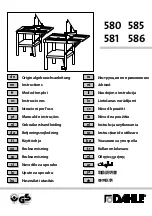
5
ENGLISH
2.3) Cutting
Continue operating the moveable handle, the lower blade advances gradually until the conductor
is fully cut.
2.4) Blade opening
Press the pressure release lever (55) for the rapid retraction of the ram and subsequent blades
re-opening.
2.5) Rest setting
After completion of the work, press the release lever to release the oil pressure (ref.
§ 2.4
).
3. WARNING
The tool is robust and requires very little daily maintenance.
Compliance with the following points, should help to maintain the optimum performance of the tool:
3.1)
Accurate cleaning
Dust, sand and dirt are a danger for any hydraulic device.
Every day, after use, the tool must be cleaned with a clean cloth, taking care to remove any residual,
especially close to pivots and moveable parts.
3.2) Storage
(Ref. to Fig. 2)
When not in use, the tool should be stored and transported in the canvas bag, to prevent damage.
Canvas Bag; ref.:
CVB-001
, Size 430x155 mm (16.9x6.1 in.); weight 0,15 kg (0.33 lbs).
3.3) Head rotation
For ease of operation, the tool head can rotate through 180°.
Warning: Do not attempt to turn the head if the hydraulic circuit is pressurised.
4. MAINTENANCE
(Ref. to Fig. 3)
Air in the hydraulic circuit may aff ect the performance of the tool; e.g: no advancement or slow
advancement of the lower blade; lower blade pulsating.
In this case proceed as follows:
4.1) To purge air bubbles from hydraulic circuit
a
– Hold tool upright in a vice with handles open (Fig. 3).
b
– Unscrew the main handle (03) from the body (12) to expose the rubber oil reservoir (02).
c
– Remove reservoir cap (01).
d
– Operate moveable handle (40), several times, in order to advance the ram (28).
e
– Press the pressure release lever (55) to retract the ram, discharge oil pressure from the circuit
and return all oil to the reservoir.
f
– Repeat points (
d
-
e
) fi ve times, to ensure all air bubbles in the hydraulic circuit are purged into
the
reservoir.
g
– If the oil level is low, top up as directed in §
4.2
.






































